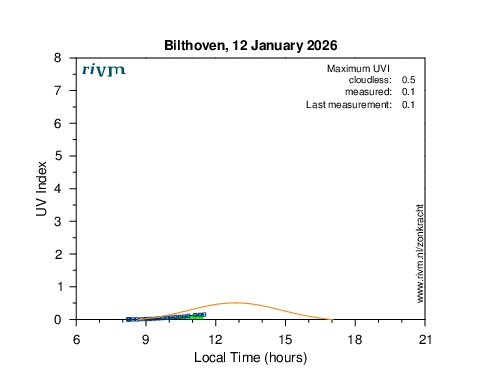The sun is constantly emitting energy. This is called radiation. Part of this radiation is visible to us. We see it as light. Another part consists of ultraviolet rays (UV radiation). These rays are invisible. UV rays are good for our health, but too much UV radiation is bad.
The UV index is a measure (number) of the amount of ultraviolet (UV) radiation in the sunlight that reaches the ground on earth. The higher the UV index, the greater the effects on our health. RIVM continuously measures the radiation from the sun in the Netherlands and uses these data to calculate the UV index. The figure below shows the UV index for today. You can use the UV index to adjust your plans, for example during sports days, outdoor work and family outings.

The orange line shows the expected UV index if the sky remains clear all day. The blue squares represent the UV index measured in Bilthoven. At the top right is the maximum expected UV index, the maximum measured thus far and the most recently measured UV index.
The UV index rises as the sun climbs in the sky and when there are fewer clouds, the ozone layer is thinner and the air is cleaner. The UV index can therefore be higher in the summer than in the winter. It can also be higher in the middle of the day than early in the morning or late in the afternoon. The UV index is not affected by the outdoor temperature. On cold summer days, the UV index can be just as high as on warm summer days.
Health effects
Sunshine puts us in a better mood and makes us want to go outside more. We take more physical exercise, which can help prevent chronic disease. UV radiation also makes our bodies produce vitamin D, which we need for healthy bones and muscles. However, too much UV radiation is bad for our health. When we get sunburnt, our skin ages more rapidly. UV radiation is also the leading cause of skin cancer. Too much sunlight can damage your eyes as well.
Protect yourself
It is important to protect yourself and your children against too much UV radiation all year round.
- Stay out of the sun as much as possible between 12:00 and 15:00.
- Cover up with sun-protective clothing and wear a wide-brimmed cap or hat.
- Wear sunglasses that offer UV protection.
- Regularly put sunscreen with a Solar Protection Factor (SPF) of at least 30 on all uncovered skin, even if you are in the shade.
- Take extra care to protect children against UV radiation. Regularly put sunscreen with an SPF of 50 on children.




